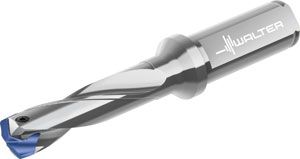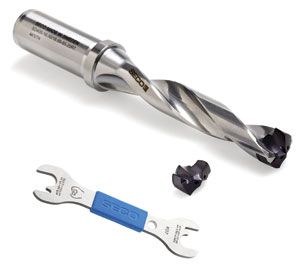by Kip Hanson
A new generation of replaceable tip drills delivers the sweet spot between indexables and solid carbide
Drills made of high-speed steel (HSS) have long been the go-to tools for holemaking. They’re tough, fairly predictable and effective, and far less expensive than alternatives such as indexable insert drills and those made of solid carbide. The problem is, they’re slow, only able to operate at roughly one fourth the cutting speed of their more robust cousins. And if you’re a fan of high pressure through-the-tool coolant, your options are limited, as most of the cutting tool industry’s efforts in this area are aimed at carbide tooling.
Yet machine shops are generally a cost-conscious lot, often opting for the most affordable tooling even if it means sacrificing productivity. This among other reasons is why cutting tool manufacturers have developed a middle-of-the-road holemaking solution, one that straddles the fence between high performing carbide and “get ‘er done at the lowest cost possible” HSS drills.
Replaceable tips made their debut a number of years ago, but as many machinists might recall, were plagued with problems, leading to lukewarm reviews. Because cutting forces are quite high during hole drilling, there was a tendency for the tip to work itself loose—most often while the drill was deep inside the hole, where it was virtually impossible to remove. According to the companies interviewed for this article, however, those bad old days are behind them, and now is an excellent time to take a look (or a second look) at replaceable tip drills.
“Cham”ping at the bit
One of these is Iscar Tools Inc. The company’s SumoCham and SumoCham IQ drilling line is now on its third generation, and David Vetrecin, product manager for holemaking, says it’s the best drill Iscar has ever produced. “We released our three-fluted SumoCham at IMTS 2018, which is able to drill from solid at substantially higher feedrates than two flute drills,” he says. “We also released our four and five millimeter two-flute SumoCham. Those particular drills are targeted at shops machining steel and cast iron, but we’ll soon be introducing versions for stainless steel and superalloys. Looking at the entire SumoCham portfolio, that means we can cover the lion’s share of all holemaking, from 4 mm (0.157 in.) all the way to 33 mm (1.299 in.), and lengths up to 12xD.”
According to Vetrecin, replaceable tip drills offer several advantages over other drilling solutions. Aside from their much lower cost compared to solid carbide, they typically run faster and more consistently, something he attributes to their forgiving nature. “Where solid carbide is extremely stiff, a replaceable tip’s steel body is able to flex a little bit,” he says. “You can push them much harder as a result, and if there’s any runout or misalignment—which virtually every machine setup has to some extent—there’s less chance of breakage.”
 Attributes to watch for
Attributes to watch for
Sarang Garud, product manager for indexable drills at Walter USA LLC, has similar things to say about his company’s D4140 drill, which replaces its older B401-type replaceable tip drill. As with the other contributors listed here, Walter offers a wide range of drill sizes, lengths, and carbide grades, yet Garud is quick to point out the drilling system’s other features.
“First of all, we have ground margins on the sides of the carbide tip,” he says. “This serves to guide the drill very well while also providing an excellent surface finish. There’s also our Color Select feature, a superficial coating that matches the carbide grade to its corresponding ISO color—for example, ISO-P is blue, right? This makes it pretty easy to avoid the costly mistake of using the wrong grade for an application. And our drill body is both polished and hardened. The flute polishing helps with chip evacuation, while the 60 Rockwell surface provides excellent wear characteristics and rigidity. In terms of performance, it’s about as close as you can get to solid carbide.”
In all fairness, at least some of these attributes, as well as those listed by Iscar, are standard fare in the replaceable tip drill market, and the best advice anyone can offer is to give several different brands a try. From Garud’s perspective, the ideal users of his drilling system—and therefore the ones who should definitely take a look—are those shops that sit in between very high production manufacturers (which should probably invest in solid carbide drills for maximum drill life) and job shops (which due to their high mix, lower volume work, often get by just fine with HSS).
For shops that do adopt a replaceable tip drilling strategy, Garud suggests they can expect to roughly double their feedrates against indexable drills, while reducing spindle speeds slightly, depending on the application and material. Another intriguing feature of these tools is their flexibility. Iscar and Walter’s drilling systems support the use of multiple tip sizes for any given head in increments of 0.1 mm (0.004 in.)—in other words, a 16 mm (0.630 in.) drill body can accept tips up to 16.9 mm (0.665 in.) in diameter.
 And the crown goes to…
And the crown goes to…
The third member of this replaceable tip drill triad is Seco Tools LLC, which has also given its legacy product a facelift recently. Its name? Crownloc Plus. “The range was a bit larger on our old Crownloc drill, and it continues to be a favoured product where cost is a concern, but the benefits of the new system definitely outweigh the old for very demanding applications,” says Manfred Lenz, holemaking product manager for North America.
What’s different about it? The biggest change is the locking mechanism, one of the key attributes (and potential failure points) for any replaceable tip drill—rather than a drawbar that pulls the tip against its locating seat, Crownloc Plus has a camlock that “really traps the insert. It simply cannot come loose.”
Says Lenz, “with a solid carbide drill, you’re getting productivity, you’re getting deeper holes. It’s more rigid, which equates to better tool life as well as improved overall accuracy, so you can meet tighter tolerances. And with indexable insert drills, it’s all about bigger holes and price per edge—you should think of them more as roughing tools. With the Crownloc Plus, you get excellent positioning accuracy, hole tolerance, and surface finish. You achieve almost the same performance as solid carbide, but at a lower cost and with additional flexibility; it’s that whole happy medium thing. It’s just a great drilling solution for a lot of different applications.” SMT
